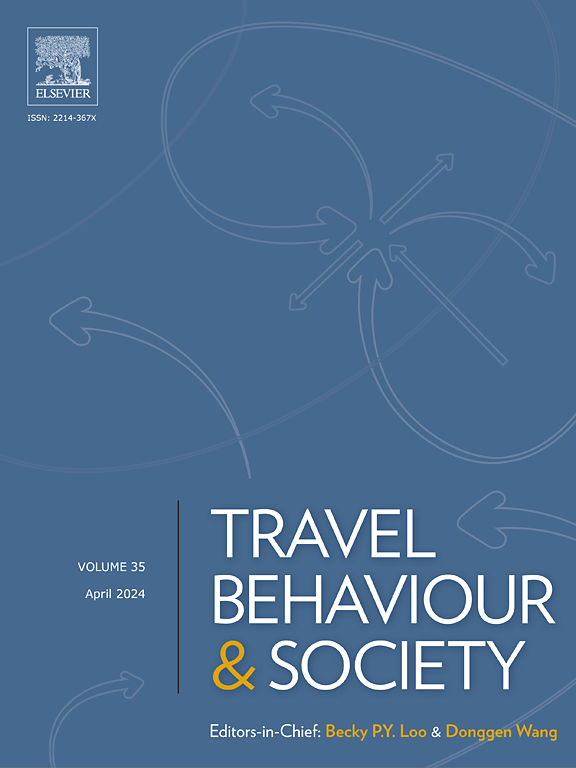了解移动即服务(MaaS)试验参与者的捆绑选择和订阅模式:来自澳大利亚大学社区的证据
IF 5.7
2区 工程技术
Q1 TRANSPORTATION
引用次数: 0
摘要
理解选择偏好和订阅捆绑包的模式是成功引入和广泛采用MaaS的关键先决条件。现有的关于MaaS捆绑包的选择偏好的研究仅限于通过陈述偏好调查的单一选择方案,或者在少数参与者的小规模试验中进行有限的选择。与在单一选择场景中观察到的行为不同,分析个人的捆绑选择和跨订阅的预算分配,基于他们的订阅顺序,提供了一种更客观的方式来理解他们的MaaS订阅模式。为了提供新的证据,本研究利用了在澳大利亚东南昆士兰(SEQ)的一个大学社区进行的大规模MaaS试验的数据,并检查了参与者在2023年第1学期的捆绑订阅。描述性分析显示,许多参与者在整个学期中重复购买相同的捆绑包或选择多种捆绑包类型。此外,似乎有一些因素不仅影响捆绑选择,而且影响学生和工作人员对MaaS项目的学期承诺。为了进一步探讨这一点,我们的研究使用多个离散连续极值(MDCEV)模型对参与者的捆绑选择和学期内订阅模式进行了建模。模型结果强调了参与者的性别、用户类型、年龄、骑电动滑板车的能力以及加入MaaS试用的动机对捆绑选择和订阅模式的显著影响。此外,与住宅自行车道密度、人口密度、土地利用组合、专用于交通的土地面积百分比相对应的土地利用变量似乎也会影响参与者对捆绑和订阅模式的偏好。所开发的模型还考虑了参与者在跨参与者配置文件的捆绑订阅中预算分配的异质性。这些发现对于理解特定MaaS捆绑包的用户订阅模式具有深刻的见解,从而指导运营商和决策者在实际的MaaS部署和运营中增强他们的捆绑包产品。本文章由计算机程序翻译,如有差异,请以英文原文为准。
Understanding bundle choices and subscription patterns of mobility as a service (MaaS) trial participants: evidence from an Australian university community
Understanding choice preferences and patterns of subscriptions to bundles is a critical prerequisite for the successful introduction and widespread adoption of MaaS. Existing studies on choice preferences for MaaS bundles are limited to a single-choice scenario through stated preference surveys, or to limited choices in small-scale trials with few participants. Unlike behaviours observed in single-choice scenarios, analysing individuals’ bundle choices and budget allocations across subscriptions, based on their subscription sequences, offers a more objective way to understand their MaaS subscription patterns. To contribute new evidence, this study utilises data from a large-scale MaaS trial conducted within a university community in South East Queensland (SEQ), Australia, and examines participants’ bundle subscriptions during semester 1 of 2023. The descriptive analysis reveals that many participants repeatedly purchase the same bundle or select multiple bundle types throughout the semester. Further, there appear to be some factors that affect not only the bundle choices but also the semester-long commitment of students and staff to the MaaS program. To explore this further, our study models participants’ bundle choices and the within-semester subscription patterns using multiple discrete–continuous extreme value (MDCEV) models. The model results highlight the significant impacts of the participants’ gender, user type, age, ability to ride an e-scooter, and motivations for joining the MaaS trial do affect bundle choices and subscription patterns over the semester. Moreover, land use variables corresponding to residential bikeway density, population density, land use mix, percentage of land area dedicated to transport, also seem to affect a participant’s preferences for bundles and subscription patterns. The developed models also account for the heterogeneity in participants’ budget allocations into bundle subscriptions across participant profiles. The findings are insightful in understanding users’ subscription patterns for specific MaaS bundles, thus guiding operators and policymakers to enhance their bundle offerings in real-world MaaS deployment and operation.
求助全文
通过发布文献求助,成功后即可免费获取论文全文。
去求助
来源期刊

Travel Behaviour and Society
TRANSPORTATION-
CiteScore
9.80
自引率
7.70%
发文量
109
期刊介绍:
Travel Behaviour and Society is an interdisciplinary journal publishing high-quality original papers which report leading edge research in theories, methodologies and applications concerning transportation issues and challenges which involve the social and spatial dimensions. In particular, it provides a discussion forum for major research in travel behaviour, transportation infrastructure, transportation and environmental issues, mobility and social sustainability, transportation geographic information systems (TGIS), transportation and quality of life, transportation data collection and analysis, etc.
 求助内容:
求助内容: 应助结果提醒方式:
应助结果提醒方式:


